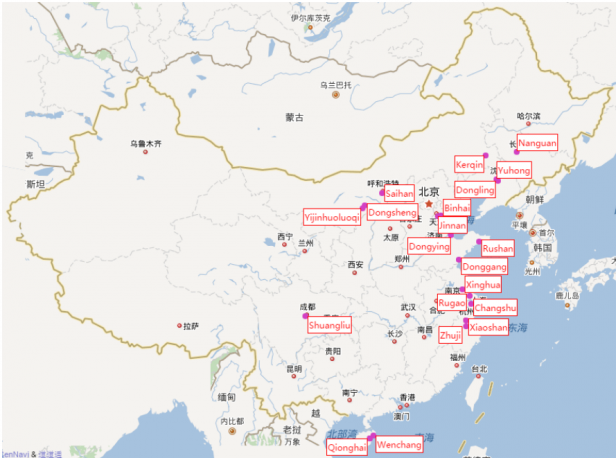博文
中国的鬼城(房地产过热的后果)
||||
数据挖掘揭示了中国的鬼城的程度
本文使用google translate翻译自
http://www.technologyreview.com/view/543121/data-mining-reveals-the-extent-of-chinas-ghost-cities/
请更喜欢原汁原味阅读该新闻的朋友往下拉,最后是英文原文。
过度发展的中国创造了或多或少无人居住的城市地区,即鬼城。没有人知道这个问题有多严重,直到百度利用其大数据实验室一探究竟。
近年来,中国经历了一定时期的史无前例的城市发展。城市生活的人数从1984年的8800/平方公里,增长到2010年的41,000。而这仅仅是开始,2011年和2013年间中国所使用的混凝土比美国在整个20世纪使用的都多。
一些这方面的建设的地域发生了供需失调。在中国各地,开发商如此之快地建立了这么多的住房,甚至在这个世界上人口最多的国家中,已经超过了需求。其结果是鬼城的出现,整个城市地区都或多或少冷清成为广为人知的现象。
但是,在很多鬼城报告的传闻是基于不可靠的测量,如晚上在住宅楼对灯的数量的简单计数。这不是一个特别准确的方法,这不仅是因为它忽视了旅游业造成的季节性变化。许多地方在旅游旺季繁忙,但淡季时为空旷。所以暂时无法与真正的鬼城区别。
这引发了一个有趣的问题:中国的鬼城问题真的存在么?
今天,感谢光华志在大数据实验室在百度的工作,百度是中国版的谷歌。同时百度也是地球上最大的网络公司(一个尝试与谷歌和亚马逊竞争世界的公司,是“中国的梦想互联网巨头”),和几个好朋友。他们已经使用了百度收集的中国的鬼城所在位置的数据。而通过跟踪的人随着时间的推移,百度的团队可以分辨出季节性的假幽灵城镇。
约700万人报名参加百度的非凡数据,在它提供的基础上得出了中国的13.6亿居民的结果。
当然,这些人主要是年轻人,因此数据并不具有广泛代表性的中国社会。然而,它确实给计算城市生活密度的方法提供了一个思考。这使得在全国各地的在一个几十米测量的分辨率上同时进行比较成为可能。
百度在2014年和2015年每天跟踪它的用户超过六个月,使用一个共同的聚类算法来计算自己的家的位置。随后,他们与相关已知住宅区另一个数据集这些地方制定出他们的住所。然后,他们计算出生活中的每个百米100米范围内的人的城市密度的数量。
中国的住房和城乡建设部的规定,一个标准的城市为该区域一平方公里的面积应容纳10000人。光华将鬼城定义为居住率只达到该数据的一半的地方。
为了找出这些地方,他们已经建立了一种算法,只需对区域狩猎的密度小于一半的中国标准。但是,他们走得更远,跟踪密度随着时间的推移,看它是否处于旅游旺季。
结果得到了有趣的解读。在中国不仅识别超过50个鬼城,他们也能够分析其空间分布,以及它如何与周边的地理环境和城市环境。
乳山市,位于靠近大海,拥有21英里美丽的海岸线已经被严重开发的。这里的房子是空的大半年,但人口密集,在旅游旺季。这清楚地表明乳山作为一个旅游中心,而不是一座空城。
相比之下,康巴什的人口变化有一个明确的每周一次的周期。这是一个明确的信号,这是一个鬼城。
这是有趣的工作,正确的第一次测量鬼城现象。而不是只计算晚上在某居住区的房屋数量与光线的指标”,“百度大数据可以实时、各地 的同时统计精确数据。
这将有助于中国政府在未来做出更好的规划决策,也提醒人们也许可以考虑搬到这些地区居住。(百度一直担心在这项研究中有排名的幽灵城市可能会影响房价。)
如果有人想进一步探索,他们都被放在一个互动网站,www.bdl.baidu.com/ghostcity他们的工作数据,任何人使用。尽情享受吧!
Data Mining Reveals the Extent of China’s Ghost Cities
Over development in China has created urban regions known as ghost cities that are more or less uninhabited. Nobody knew how bad the problem was until Baidu used its Big DataLab to find out.
In recent years, China has undergone a period of urban growth that is unprecedented in human history. The number of square kilometers devoted to urban living grew from 8,800 in 1984 to 41,000 in 2010. And that was just the start. China used more concrete between 2011 and 2013 than the U.S. used in the entire 20th century.
Some of this building has been misplaced. In various parts of China, developers have built so much housing so quickly that it has out stripped demand, even in the world’s most populous country. The result is the well-publicized phenomenon of ghost cities—entire urban areas that are more or less deserted.
But much of the reporting on ghost cities is an ecdotal or based on unreliable measurements such as a simple count of the number of lights on at night in residential buildings. That’s a particularly inaccurate method, not least because it ignores seasonal variations caused by tourism. Many places are busy during the tourist season but empty during the off-season, and not just in China. So being unable to distinguish these from ghost cities is something of a problem.
And that raises an interesting question: how bad, really, is the problem of ghost cities in China?
Today we get an answer of sorts thanks to the work of Guanghua Chi at the Big DataLab at Baidu, China’s version of Google and one of the biggest Web companies onthe planet (for an inside look at Baidu’s attempt to compete with the Googles and Amazons of the world, see “A Chinese Internet Giant Starts to Dream”), and a few pals. These guys have used the location data that Baidu gathers about its users to work out exactly where China’s ghost cities lie. And by tracking people over time, the Baidu team can distinguish between ghost cities and towns that are seasonally empty.
Baidu has an extraordinary data base to draw on. Some 700 million people have signed up for the services it offers, a significant proportion of China’s 1.36 billion inhabitants.
Of course, these people are predominantly younger so the data is not broadly representative of Chinese society. However, it does give an idea of urbandensity and how this varies both in time and across the country at a resolution measured in a few tens of meters.
Baidu tracked its users throughout each day for more than six months in 2014 and 2015 and used a common clustering algorithm to calculate their home location. They then correlated these locations with another data set of known residential areas to work out where they lived. They then calculated the urban density—the number of people living in each 100 meter by 100 meter area.
The Chinese Ministry of Housing and Urban-Rural Development states that a standard urban region with an area of one square kilometer should house 10,000 people.Guanghua and co define a ghost city as an area with half this density.
To find out where these areas lie, they’ve built an algorithm that simply hunts for areas with a density that is less than half the Chinese standard. But they go further and track the density over time to see whether it picks up during the tourist season.
The results make for interesting reading. Not only does the team identify more than 50 ghost cities in China, they are also able to analyze their spatial distribution and how it relates to the surrounding geography and urban setting.
They give as an example the city of Rushan, which is located near the sea and has 21miles of beautiful coast line that has been heavily developed. The houses here are empty for much of the year but densely populated during the tourist season.This clearly shows Rushan as a tourism center rather than a ghost town.
By contrast, the city of Kangbashi has a clear weekly cycle of population change albeit with very low density of residents. That’s a clear sign that this is aghost city.
That’s interesting work that properly measures the ghost city phenomenon for the first time. “Instead of just counting the number of homes with light at night incertain residential areas as the indicator of “ghost city,” Baidu big data can count the population precisely, in real time, and in national scale,” sayGuanghua and co.
That should help the Chinese government make better planning decisions in future and should also inform people thinking of moving to these areas. (Baidu has been careful not to rank the ghost cities in this study for fear of influencing property prices there.)
And if anybody wants to explore further, these guys have put their work data on an interactive website, www.bdl.baidu.com/ghost city, for anybody to use. Enjoy!
https://m.sciencenet.cn/blog-5525-935980.html
上一篇:广告两则
下一篇:2016年新年贺词——致上海优秀男人

